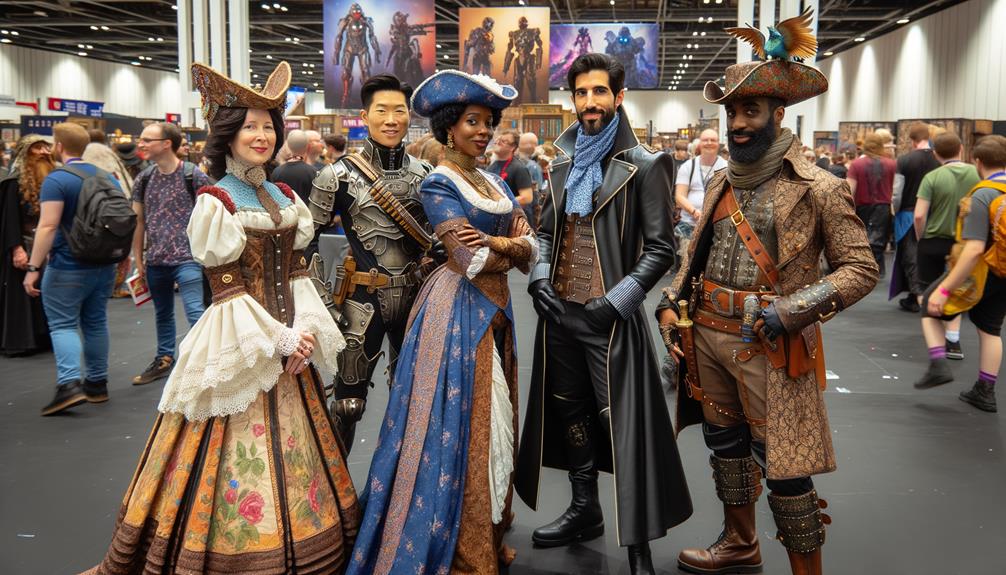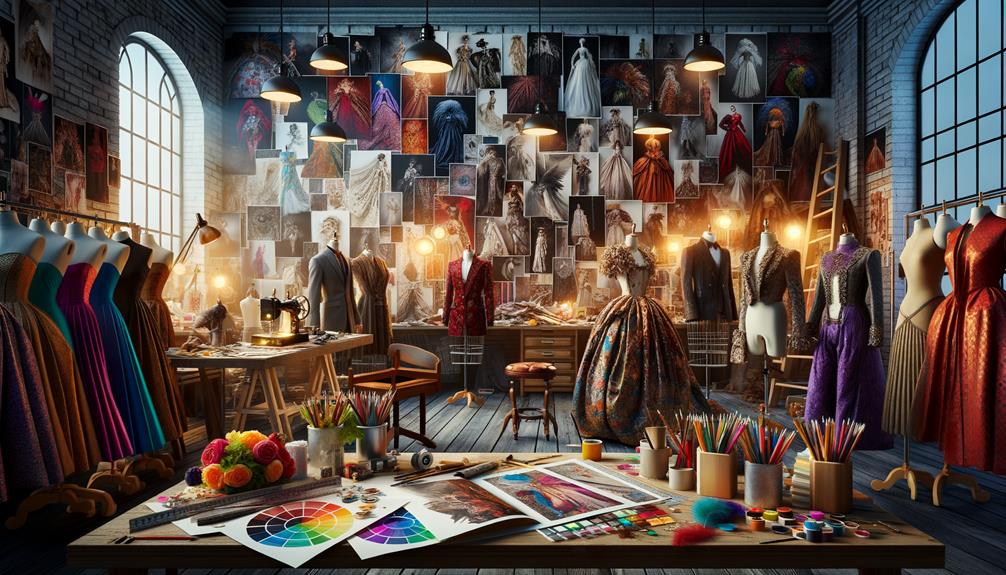I've always believed that costumes have a profound impact on how we perceive characters. The right outfit can expose hidden traits, convey humor, or command respect. Beyond just clothes, costumes communicate inner struggles and emotions through symbolic colors and textures. Unique choices in fabric and accessories reflect individuality. Costumes also bring group dynamics to life, signaling connections or tensions without needing words. It's fascinating how these elements combined paint a vivid picture of a character's inner world and social standing. There's more to explore about how costumes shape our understanding of characters.
Revealing Hidden Traits
A costume often uncovers aspects of one's personality that usually remain hidden. When I delve into costume design, I plunge into understanding the characters deeply. It's not just about fabric and colors; it's about revealing the layers beneath the surface. Each stitch, each accessory, contributes to a fuller picture of who the character is.
The process demands a sharp eye for detail and empathy. I need to create a sense of authenticity that resonates with the character's inner world. It's fascinating to watch how a carefully chosen costume can transform someone. Suddenly, they walk differently, speak with newfound confidence, or even adopt mannerisms they never knew they had.
This transformation isn't just for the observer; it's a revelation for the wearer too. They begin to understand themselves in ways they hadn't before. Costume design becomes a conduit for self-discovery. By bringing these hidden traits to the forefront, I help people connect with deeper parts of their psyche. It's a powerful form of expression that transcends mere clothing and taps into the essence of human identity.
Expressing Humor and Playfulness
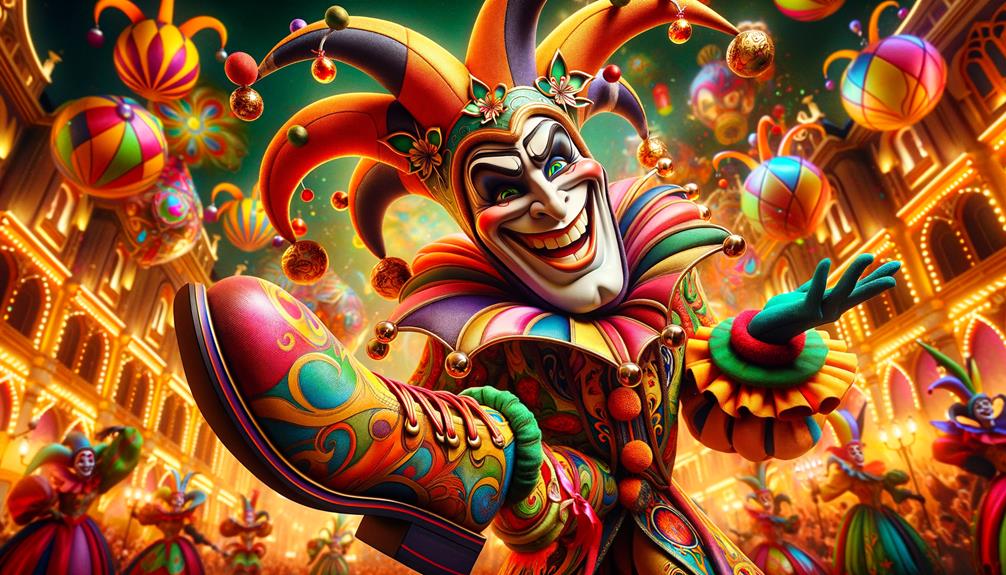
Costumes allow us to showcase the lighter side of our personalities, revealing humor and playfulness that everyday attire can't capture. When I wear a costume, I often express a facet of myself that remains hidden in daily life, connecting with others on a different level.
Through costumes, I become a character that audiences can quickly understand and appreciate. A well-chosen outfit can convey a sense of humor that words alone might struggle to express. In this way, costumes serve as a bridge, facilitating immediate audience understanding of my playful side.
Moreover, costumes often reflect our imaginative desires to break free from the mundane. Dressed as a jester or a fantastical creature, I feel liberated, unshackled by the expectations of routine clothing. This freedom to express humor and playfulness is both exhilarating and revealing, offering a glimpse into the lighter aspects of our psyche.
Ultimately, wearing costumes transforms me, allowing my playful nature to surface and engage with others. Through this sartorial expression, I find a unique way to communicate joy and creativity, often sparking innovative interactions.
Showcasing Power and Authority
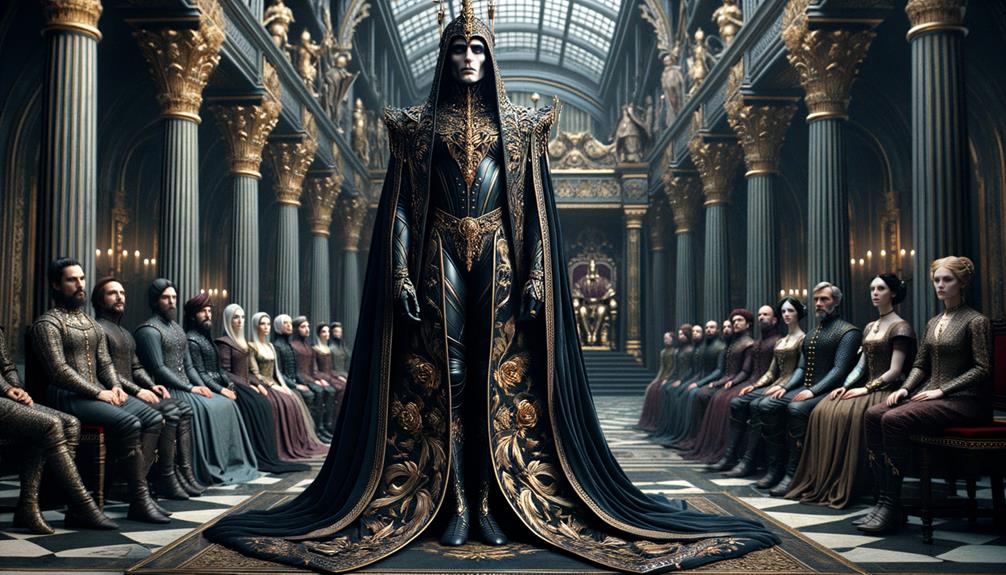
When I wear certain clothes, I embody power and authority. Each piece I choose is more than just fabric – it's a symbol. My wardrobe choices signal social status, an unspoken language of dominance.
A well-tailored suit, sharp and precise, commands attention. It's not just about fit; it's about the statement it makes. The fine lines of the suit reflect discipline, control, and confidence. I notice how people respond – heads turn, conversations shift. They recognize the authority before I even speak.
Colors also play a role. Deep, rich hues like navy or black convey seriousness and gravitas. They're not just colors; they're signals. When I wear a black blazer, the message is clear: I'm here to lead. Accessories like a sleek watch or minimalist cufflinks add subtle layers of sophistication, reinforcing my position without being too flashy.
In this way, my attire becomes an extension of my identity, a crafted exterior that communicates my place in the social hierarchy. Through calculated choices, I don't just dress for the role – I become the role. It's a seamless blend of appearance and intention, where clothing becomes a powerful tool.
Highlighting Internal Conflicts
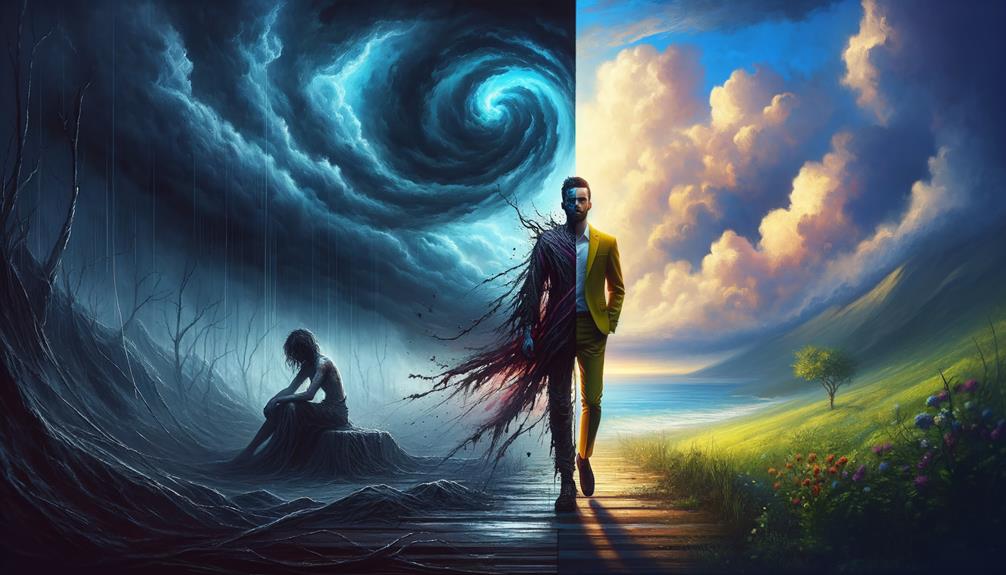
When analyzing costumes, I notice how they visually represent internal conflicts through contrasting elements and symbolic colors. Characters often wear outfits that reflect their inner struggles, and these outfits transform to mirror shifts in their emotional and psychological states.
Duality in Costume Choices
How does a character's costume reveal their inner turmoil and dual nature? When a superhero puts on their suit, they're not just preparing for battle; they're facing the tension between their heroic persona and civilian life. The stark contrast between their costume and everyday attire symbolizes the struggle to balance these identities. This visual representation makes their internal conflict palpable.
Consider a villain whose costume reflects their troubled past. Elements like tattered fabrics or symbolic accessories tell a story of inner chaos, inviting the audience to empathize with their internal struggle. Masks and disguises serve a similar purpose, concealing true identities and reflecting battles with self-acceptance.
The duality in costume choices goes beyond aesthetics. It's about using visual cues to explore the psyche of a character. Contrasting colors, diverse fabrics, and carefully chosen accessories work together to portray inner conflicts. These choices don't just dress a character; they narrate their internal journey, making their struggles relatable and compelling. This innovative approach to costuming transforms it into a narrative tool that deepens our understanding of character complexity.
Symbolic Color Schemes
Colors in costumes reveal the silent battles characters fight within themselves. I've always believed that a character's internal struggle can be laid bare through the hues they wear. Red might signify passion, but also rage. Blue can evoke calm, yet hint at profound melancholy. These choices aren't just aesthetic; they're narrative tools, shaping our understanding of the character's psyche.
When I think of a hero in a dark costume, I see more than just a fighter against external evil. I see a soul wrestling with their own darkness. The contrast of light and dark colors in an outfit can mirror the duality within a character, their good intentions clashing with darker impulses.
Even subtle color shifts matter. A protagonist might start in soft pastels, but as their journey gets grimmer, they evolve into deeper, more somber tones. This visual representation of their emotional state adds depth to the storytelling.
Analyzing these color schemes, I appreciate the layers of storytelling. The palette is deliberate, a visual dialogue with the audience. It's a reminder that beneath the surface, there's always more than meets the eye.
Transformation Through Attire
A character's attire often transforms to reflect their inner turmoil and growth. I see this transformation as a visual narrative, intertwining the psychological with the tangible. Clothes aren't just fabric; they're an extension of the self, conveying struggles and triumphs.
When analyzing a character's wardrobe evolution, I notice how subtle shifts convey significant meaning. A hero's journey often begins with modest, muted tones, reflecting insecurity or anonymity. As their confidence grows, their attire becomes bolder, more defined. This isn't just about fashion; it's about signaling internal change to the audience.
Conversely, a character descending into chaos might show this through disheveled or increasingly dark attire. These choices aren't arbitrary. They underscore a fractured psyche. The tattered hem or unbuttoned shirt becomes a metaphor for unraveling control.
Transformation through attire is a powerful storytelling tool. It's a silent dialogue between the character and the viewer, revealing what words might conceal. When costume designers and writers collaborate closely, the result is a richer, more immersive experience. In these details, innovation in character development truly shines.
Celebrating Individuality
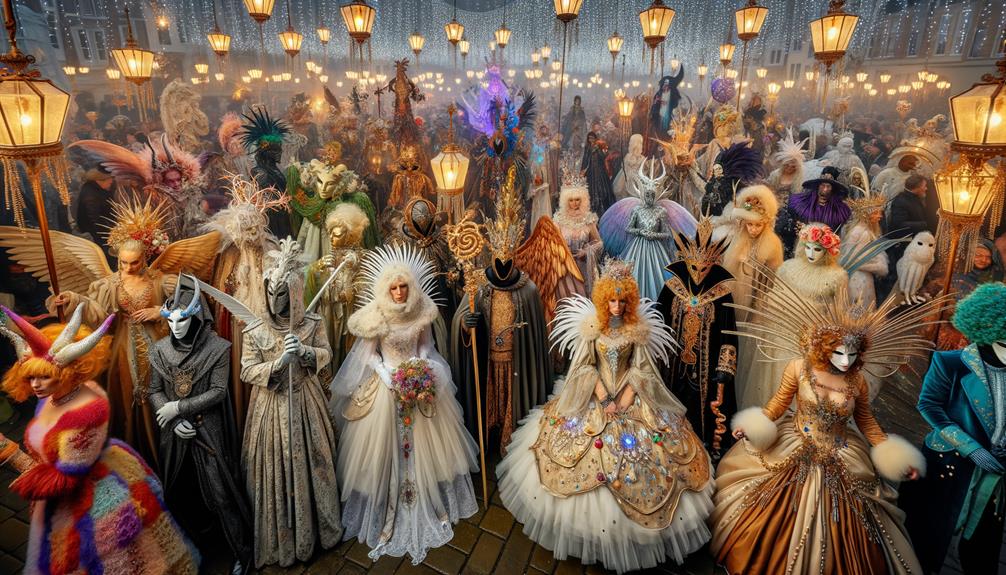
Choosing a costume is a personal statement that showcases my unique personality, values, and perspective. When I select a costume, I'm not just putting on fabric; I'm making a declaration about who I am and what matters to me. Each element I choose says something about my individual tastes and preferences.
When celebrating individuality through costumes, several aspects come into play:
- Color Choices: Vibrant hues might suggest a bold personality, while muted tones imply a preference for subtlety.
- Character Selection: Opting for a superhero versus a historical figure reveals my aspirations or interests.
- Material and Texture: The feel of the fabric – whether luxurious velvet or rugged denim – shows my comfort zones.
- Accessories: Including specific items like hats, masks, or jewelry highlights my personal quirks or significant traits.
- Customization: Adding personal touches, alterations, or DIY elements showcases my creativity and originality.
Each time I decide on a costume, it's a moment of self-reflection. What do I want to convey? How do I see myself? It's a process that celebrates my uniqueness and invites others to see the world through my eyes, if only for a moment.
Emphasizing Social Connections
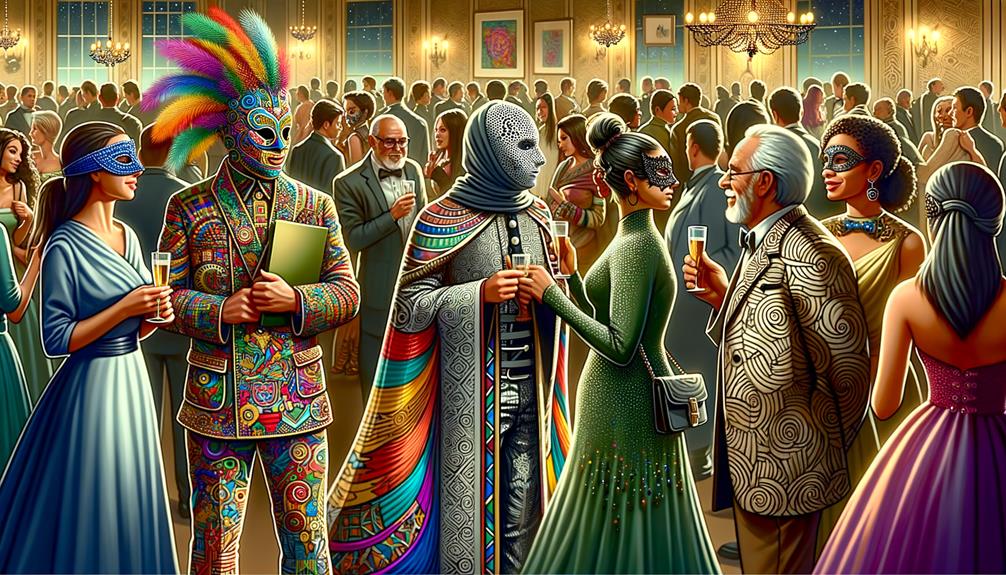
When I put on a costume, I notice how it changes the way I interact with others. It helps me build connections with friends and makes group dynamics at parties more enjoyable. Wearing a costume makes it easier to share experiences and bond with others.
Building Character Relationships
Costumes are more than just attire – they're silent conversation starters that weave threads of connection between characters. What a character wears can subtly hint at their relationships with others. A shared color scheme or accessory can signal an alliance, while contrasting styles may suggest a clash or tension. Costumes communicate nuances, deepening the narrative without uttering a word.
When analyzing costumes to build character relationships, several factors come into play. Matching hues can indicate unity or a shared purpose. Luxurious fabrics might denote status or intimacy. Shared jewelry or insignias hint at connections. Period-specific attire can align characters with a common past. Distressed clothing might reveal shared hardships or struggles.
Reflecting on these elements, it's clear how they weave an intricate web of social connections. Costumes become a visual dialogue, revealing who trusts whom, who fears whom, and who stands together. They silently narrate the underlying dynamics, inviting the audience to unravel the story's deeper layers. Through thoughtful costume design, relationships are not just seen but felt, adding a rich texture to the characters' interactions.
Enhancing Group Dynamics
How do costumes transform group dynamics and foster deeper social connections? When I see someone dressed in a similar theme, it sparks a conversation starter. This shared visual language helps break the ice, making interactions smoother and more engaging.
The anonymity that costumes provide is another layer. Hidden behind a mask or a character, I feel more liberated to express myself. This openness can lead to more honest and meaningful exchanges, fostering a stronger sense of community.
Costume events, like Halloween parties, offer a unique social setting. The festive atmosphere and creative outfits help dismantle social barriers. I find myself in playful and creative interactions, stepping out of my comfort zone, leading to stronger social bonds.
When we all dress up, it creates a shared experience. This shared identity fosters a sense of belonging. Group dynamics improve as everyone feels part of a collective narrative. It's not just about individual expression but about creating a cohesive, inclusive environment.
In essence, costumes don't just reflect personalities; they enhance group dynamics by promoting social connections, breaking down barriers, and fostering a sense of community and belonging.
Frequently Asked Questions
What Can Costumes Tell Us About a Character?
Costumes tell a story. They reveal the choices people make, their history, and what they desire deep down. By examining what someone wears, I uncover layers of their identity and what drives them. Every detail counts; it's a visual language that's waiting to be understood.
How Does Costume Impact a Character?
Costumes have a profound impact on our perception of characters. They instantly convey a sense of identity and backstory, allowing us to connect with the character on a deeper level even before they speak. This powerful tool can revolutionize the narrative, adding depth and complexity to the story.
How Do Costumes Contribute to How You See the Characters?
Costumes play a significant role in shaping my understanding of characters by providing visual cues about their roles, social status, and personal growth. They instantly connect me to the character, making abstract traits more relatable and tangible, and add depth to the narrative, which in turn increases my engagement with the story.
What Is the Psychology Behind Costumes?
The allure of costumes lies in their ability to provide a safe space for self-expression. By donning a disguise, individuals can tap into hidden aspects of their personality, freely exploring traits they might otherwise keep concealed.



